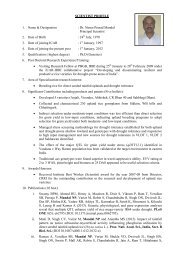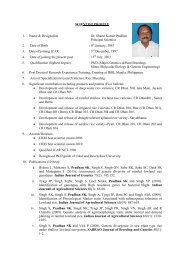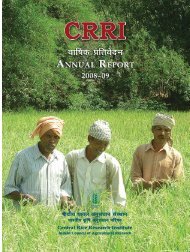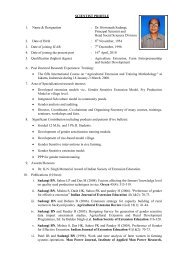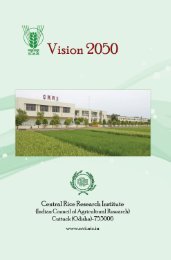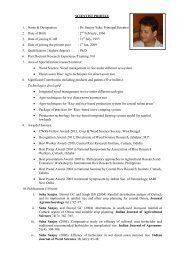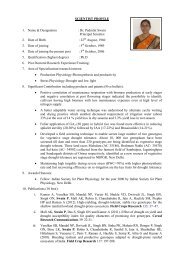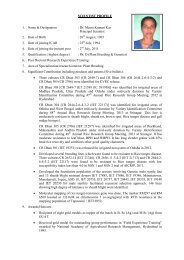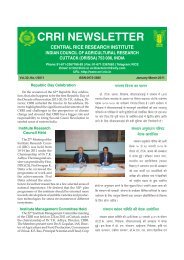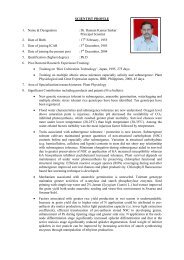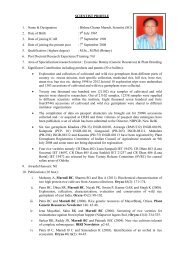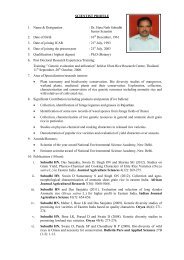Central Rice Research Institute Annual report...2011-12
Central Rice Research Institute Annual report...2011-12
Central Rice Research Institute Annual report...2011-12
You also want an ePaper? Increase the reach of your titles
YUMPU automatically turns print PDFs into web optimized ePapers that Google loves.
grain yield was recorded highest (2.72 t ha -1 ) in<br />
Carbendazim 50%WP @2 gm ltr -1 treated plot compared<br />
to 1.21 t ha -1 in the control plot (Table 37).<br />
Synthesis and characterization of biodegradable<br />
polymer-pesticide composites<br />
Chitosan-formaldehyde (2.5% Chitosan solution in<br />
100 ml of distilled water + 100 g commercial grade<br />
Furadon-3G) cross linked compounds were prepared<br />
by taking 5.00%, 7.50% and 10.00% formaldehyde. The<br />
jelly like mass was dried at 60 o C to form coated<br />
carbofuran (Furadon 3G) granules. The absorbance<br />
maxima of furadon 3G was confirmed by UV spectroscopy<br />
and was found to be l max<br />
= 238 nm. Preliminary<br />
release studies revealed that the formulation CF-F10<br />
(Chitosan+Furadon+Formaldehyde 10%) exhibited a<br />
prolonged release compared to that of the other formulations.<br />
Faunal diversity and utilization of predators,<br />
parasites and pathogens for management of<br />
insect pests of rice<br />
Three bio-pesticides, based on Verticillium lecani,<br />
Metarhizium anisopliae, Beauveria bassiana and three<br />
granular insecticides viz., Cartap, Carbofuran, Phorate<br />
were applied in the rice field to study its effect on faunal<br />
diversity. It was observed that nine species of<br />
arthropods were observed in plots treated with Cartap<br />
compared to eleven species in control. In other treatments<br />
the species richness varied from six to eight.<br />
Maximum number of spiders (3.7 spiders sweep -1 ) were<br />
also observed in plots treated with Cartap and on par<br />
with control. Phorate affected species abundance negatively.<br />
Results in the field testing of the bio-pesticides<br />
indicated that formulation of M. anisopliae could reduce<br />
the larval population of Cnaphalocrocis medinalis (Guen.)<br />
to two larvae hill -1 compared four larvae hill -1 in control.<br />
The population of predatory spiders and odonates<br />
were least affected under this treatment. Under green<br />
house condition nymphal survival of WBPH was minimum<br />
(60%) five days after the treatment of M. anisopliae<br />
formulation.<br />
Faunal diversity under SRI and extent of egg<br />
parasitism of yellow stem borer<br />
Faunal diversity was studied on variety Lalat in the<br />
field during both the season with emphasis on pests<br />
and predators. During wet season yellow stem borer<br />
attack was 6.68% DH at vegetative stage under SRI,<br />
while it was 9.<strong>12</strong>% in the non-SRI plot. During dry season,<br />
DH was 10.16% under SRI and 20.95% in conventional<br />
plot indicating prevalence of unfavourable conditions<br />
for YSB attack under SRI.<br />
Eighteen species of arthropods were observed on<br />
Lalat under conventional method of cultivation compared<br />
to 13 species under SRI during wet season. GLH<br />
population was 22 insects sweep -1 under conventional<br />
method of cultivation compared to <strong>12</strong> insects under SRI.<br />
Among the predators average spider population was<br />
5.5 spiders sweep -1 , 4.5 damselflies sweep -1 under SRI<br />
as compared to 3.5 spiders sweep -1 and 3.3 damselflies<br />
sweep -1 under conventional method of cultivation.<br />
During 4 th week of October 48% egg mass wise parasitism<br />
due to Telenomus dignoides (Nixon) was observed<br />
in the field followed by 25% parasitism by Tetrastichus<br />
schoenobii (Ferr.). By the end of November the extent of<br />
parasitism declined. During wet season in the 2 nd week<br />
and 3 rd week of February, parasitism due to T. dignoides<br />
was as high as 65% on egg mass basis followed by<br />
Trichogramma japonicum (Ashm.)(<strong>12</strong>.5%), T. dignoides<br />
was the dominant parasitoid during both the seasons.<br />
Pheromones and botanical grain protectants<br />
against rice storage insects<br />
In the CRRI Farm godown (Dry season -2011 harvest)<br />
having about 200 paddy bags, pheromone for<br />
Sitotroga cerealella (Oliv.) [(Z6-E11)16Ac] was evaluated<br />
using greased plastic trays to trap and kill purpose during<br />
August-2011. There were seven traps at equal distance.<br />
Number of male moth trapped ranged from <strong>12</strong>8-<br />
496 trap -1 within 24 hrs of placement. Periodical observations<br />
showed that there was a sharp decline in moth<br />
population after one week and moth catch reduced by<br />
96.48% on 20 th day of the trappings (Table 38).<br />
Greased plastic trays as pheromone trap for Sitotroga<br />
cerealella<br />
86 CRRI ANNUAL REPORT 2011-<strong>12</strong>



